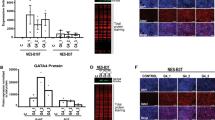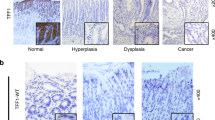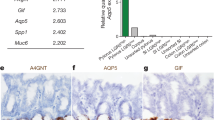Abstract
We reported earlier that RUNX3 is expressed in human and mouse gastrointestinal tract (GIT) epithelium and that it functions as a tumor suppressor in gastric and colorectal tissues. However, there have been conflicting reports describing the absence of Runx3 in GIT epithelial cells. A part of the controversy may be derived from the use of a specific antibody by other groups (referred to as G-poly). Here, we show further evidence to support our earlier observations and provide a possible explanation for this apparent controversy. We generated multiple anti-RUNX3 monoclonal antibodies and found that RUNX3 antibodies recognizing the RUNX3 N-terminal region (residues 1–234) react with RUNX3 in gastric epithelial cells, whereas those recognizing the C-terminal region (beyond residue 234) did not. G-poly primarily recognizes the region beyond 234 and hence, is unable to detect Runx3 in this tissue.
This is a preview of subscription content, access via your institution
Access options
Subscribe to this journal
Receive 50 print issues and online access
$259.00 per year
only $5.18 per issue
Buy this article
- Purchase on Springer Link
- Instant access to full article PDF
Prices may be subject to local taxes which are calculated during checkout



Similar content being viewed by others
References
Brenner O, Levanon D, Negreanu V, Golubkov O, Fainaru O, Woolf E et al. (2004). Loss of Runx3 function in leukocytes is associated with spontaneously developed colitis and gastric mucosal hyperplasia. Proc Natl Acad Sci USA 101: 16016–16021.
Carvalho R, Milne ANA, Polak M, Corver WE, Offerhaus GJA, Weterman MAJ . (2005). Exclusion of RUNX3 as a tumour-suppressor gene in early-onset gastric carcinomas. Oncogene 24: 8252–8258.
Chen CL, Broom DC, Liu Y, de Nooij JC, Li Z, Cen C et al. (2006a). Runx1 determines nociceptive sensory neuron phenotype and is required for thermal and neuropathic pain. Neuron 49: 365–377.
Chen AI, de Nooij JC, Jessell TM . (2006b). Graded activity of transcription factor runx3 specifies the laminar termination pattern of sensory axons in the developing spinal cord. Neuron 49: 395–408.
Chi XZ, Yang JO, Lee KY, Ito K, Sakakura C, Li QL et al. (2005). RUNX3 suppresses gastric epithelial cell growth by inducing p21WAF/Cip1 expression in cooperation with transforming growth factor β-activated SMAD. Mol Cell Biol 25: 8097–8107.
Inoue Ki, Ozaki S, Shiga T, Ito K, Masuda T, Okado N et al. (2002). Runx3 controls the axonal projection of proprioceptive dorsal root ganglion neurons. Nat Neurosci 5: 946–954.
Inoue Ki, Ito K, Osato M, Lee B, Bae SC, Ito Y . (2007). The transcription factor Runx3 represses the neurotrophin receptor TrkB during lineage commitment of dorsal root ganglion neurons. J Biol Chem 282: 24175–24184.
Ito K, Liu Q, Salto-Tellez M, Yano T, Tada K, Ida H et al. (2005). RUNX3, a novel tumor suppressor, is frequently inactivated in gastric cancer by protein mislocalization. Cancer Res 65: 7743–7750.
Ito K, Lim ACB, Salto-Tellez M, Motoda L, Osato M, Chuang LSH et al. (2008). RUNX3 attenuates β-catenin/T cell factors in intestinal tumorigenesis. Cancer Cell 14: 226–237.
Ito Y . (2008). RUNX genes in development and cancer: regulation of viral gene expression and the discovery of RUNX family genes. Adv Cancer Res 99: 33–76.
Katuri V, Tang Y, Li C, Jogunoori W, Deng CX, Rashid A et al. (2006). Critical interactions between TGF-β signaling/ELF, and E-cadherin/β-catenin mediated tumor suppression. Oncogene 25: 1871–1886.
Kramer I, Sigrist M, de Nooij JC, Taniuchi I, Jessell TM, Arber S . (2006). A role for runx transcription factor signaling in dorsal root ganglion sensory neuron diversification. Neuron 49: 379–393.
Le XF, Groner Y, Kornblau SM, Gu Y, Hittelman WN, Levanon D et al. (1999). Regulation of AML2/CBFA3 in hematopoietic cells through the retinoic acid receptor α-dependent signaling pathway. J Biol Chem 274: 21651–21658.
Levanon D, Bettoun D, Harris-Cerruti C, Woolf E, Negreanu V, Eilam R et al. (2002). The Runx3 transcription factor regulates development and survival of TrkC dorsal root ganglia neurons. EMBO J 21: 3454–3463.
Levanon D, Brenner O, Negreanu V, Bettoun D, Woolf E, Eilam R et al. (2001). Spatial and temporal expression pattern of Runx3 (Aml2) and Runx1 (Aml1) indicates non-redundant functions during mouse embryogenesis. Mech Dev 109: 413–417.
Levanon D, Brenner O, Otto F, Groner Y . (2003). Runx3 knockouts and stomach cancer. EMBO Rep 4: 560–564.
Li QL, Ito K, Sakakura C, Fukamachi H, Inoue Ki, Chi XZ et al. (2002). Causal relationship between the loss of RUNX3 expression and gastric cancer. Cell 109: 113–124.
Marmigère F, Montelius A, Wegner M, Groner Y, Reichardt LF, Ernfors P . (2006). The Runx1/AML1 transcription factor selectively regulates development and survival of TrkA nociceptive sensory neurons. Nat Neurosci 9: 180–187.
Nakamura S, Senzaki K, Yoshikawa M, Nishimura M, Inoue Ki, Ito Y et al. (2008). Dynamic regulation of the expression of neurotrophin receptors by Runx3. Development 135: 1703–1711.
Osaki M, Moriyama M, Adachi K, Nakada C, Takeda A, Inoue Y et al. (2004). Expression of RUNX3 protein in human gastric mucosa, intestinal metaplasia and carcinoma. Eur J Clin Invest 34: 605–612.
Oshimo Y, Oue N, Mitani Y, Nakayama H, Kitadai Y, Yoshida K et al. (2004). Frequent loss of RUNX3 expression by promoter hypermethylation in gastric carcinoma. Pathobiology 71: 137–143.
Peng Z, Wei D, Wang L, Tang H, Zhang J, Le X et al. (2006). RUNX3 inhibits the expression of vascular endothelial growth factor and reduces the angiogenesis, growth, and metastasis of human gastric cancer. Clin Cancer Res 12: 6386–6394.
Taniuchi I, Osato M, Egawa T, Sunshine MJ, Bae SC, Komori T et al. (2002). Differential requirements for Runx proteins in CD4 repression and epigenetic silencing during T lymphocyte development. Cell 111: 621–633.
Torquati A, O'Rear L, Longobardi L, Spagnoli A, Richards WO, Beauchamp RD . (2004). RUNX3 inhibits cell proliferation and induces apoptosis by reinstating transforming growth factor beta responsiveness in esophageal adenocarcinoma cells. Surgery 136: 310–316.
Usui T, Aoyagi K, Saeki N, Nakanishi Y, Kanai Y, Ohki M et al. (2006). Expression status of RUNX1/AML1 in normal gastric epithelium and its mutational analysis in microdissected gastric cancer cells. Int J Oncol 29: 779–784.
Wei D, Gong W, Oh SC, Li Q, Kim WD, Wang L et al. (2005). Loss of RUNX3 expression significantly affects the clinical outcome of gastric cancer patients and its restoration causes drastic suppression of tumor growth and metastasis. Cancer Res 65: 4809–4816.
Woolf E, Xiao C, Fainaru O, Lotem J, Rosen D, Negreanu VB et al. (2003). Runx3 and Runx1 are required for CD8 T cell development during thymopoiesis. Proc Natl Acad Sci USA 100: 7731–7736.
Yano T, Ito K, Fukamachi H, Chi XZ, Wee HJ, Inoue Ki et al. (2006). The RUNX3 tumor suppressor upregulates Bim in gastric epithelial cells undergoing TGF-β-induced apoptosis. Mol Cell Biol 26: 4474–4488.
Zavros Y, Eaton KA, Kang W, Rathinavelu S, Katukuri V, Kao JY et al. (2005). Chronic gastritis in the hypochlorhydric gastrin-deficient mouse progresses to adenocarcinoma. Oncogene 24: 2354–2366.
Author information
Authors and Affiliations
Corresponding author
Rights and permissions
About this article
Cite this article
Ito, K., Inoue, Ki., Bae, SC. et al. Runx3 expression in gastrointestinal tract epithelium: resolving the controversy. Oncogene 28, 1379–1384 (2009). https://doi.org/10.1038/onc.2008.496
Received:
Revised:
Accepted:
Published:
Issue Date:
DOI: https://doi.org/10.1038/onc.2008.496
Keywords
This article is cited by
-
The mechanisms of gastric mucosal injury: focus on initial chief cell loss as a key target
Cell Death Discovery (2023)
-
RUNX3 acts as a tumor suppressor in breast cancer by targeting estrogen receptor α
Oncogene (2012)
-
RUNX3 Downregulation in Human Lung Adenocarcinoma is Independent of p53, EGFR or KRAS Status
Pathology & Oncology Research (2012)
-
Association between RUNX3 promoter methylation and gastric cancer: a meta-analysis
BMC Gastroenterology (2011)
-
Runx3 is required for the differentiation of lung epithelial cells and suppression of lung cancer
Oncogene (2010)



